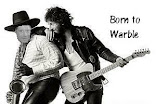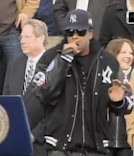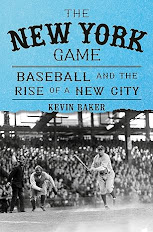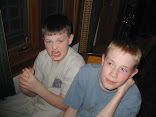—Terry Cashman
I have a terrible confession to make. I didn't always love Willie Mays.
When I first started following baseball, as the age of eight, sportswriters were intent on asking who was better, Mays or my idol, Mickey Mantle. In the utterly partisan way of a young boy, of course I hated anyone they said was better than my guy.
It took my Uncle Bruce, one of the best people I have ever known, to set me straight, taking me to see Mays play at Shea Stadium. It is just one of the many things I owe him for.
But the debate continues, spurred on by that Terry Cashman song: who was better? Willie, Mickey, or the Duke?
First, it's amazing that there could ever have been such a congregation of talent at one position, in one town, at the same time. It's as if Jabbar, Russell, and Chamberlain were all playing center, at the peak of their careers, in the same city. I don't think there's anything in sports really comparable to it.
The general consensus is that The Duke of Flatbush comes in a distant third, which is really astonishing, considering just how great he was.
Snider led the decade of the 1950s in home runs—and in RBI, runs scored, and slugging. He hit 11 home runs in the World Series, good for fourth place, including two Series when he hit 4 homers—something no one else has ever done.
He was also considered an excellent baserunner and a terrific outfielder by those who saw him play. Vin Scully, for one, thought his reputation as an outfielder suffered "because of playing in a small ballpark, Ebbets Field. When he had a chance to run and move defensively, he had the grace and the abilities of DiMaggio and Mays..."
In general, it seemed, the Duke's reputation suffered from making everything look too easy.
"If Baryshnikov were a ballplayer, this is what he would look like," claimed Jim Murray. "The Duke was never off balance, out of sync. This is the way you would teach kids to swing. The Duke not only looked good striking out, he looked good popping up."
What limited his greatness was injuries—and his native California. Just 31 when the Dodgers left for L.A., The Duke never hit more than 23 home runs or had more than 370 at-bats in a season again.
Which gets it down to two.
The Mick was an incredible ballplayer—especially when you consider that he played 17 of his 18 seasons with a torn ACL that was never properly repaired. Incessant waves of other injuries followed.
Nonetheless, he was able to steal 153 bases in 191 attempts, and beat out "twenty to thirty" bunts a season, in his prime. In those 18 seasons, The Mick grounded into just 113 double-plays—about 8 a season, compared to 14 a year for Mays, and 13 for Snider. In both 1953 and 1961, he grounded into just 2 double-plays, all year long.
Coming out of the box, he was incredibly fast—3.1 seconds going from the left-handed batter's box to first, the fastest that's ever been timed. Even from the right-handed batter's box he seems to have been just a blink faster than Mays.
He was also an outstanding outfielder, much as he put down his own ability in the field. The one-handed, running catch he made in the 1956 World Series, to preserve Don Larsen's perfect game, was so far out it would've been in the seats in Ebbets Field.
So, who was better?
At his very best—and his best lasted a long time—it would have been The Mick, according to almost any modern, statistical measure: Peter Palmer and John Thorn's "batter-fielder-wins" measure for Baseball Encyclopedia, Cyril Morong's "win shares per at-bat" (which ranks Mantle second only to Babe Ruth in baseball history), and Bill James' "win shares" Sabremetric.
"Mickey Mantle was, at his peak in 1956-1957, and again in 1961-1962, clearly a greater player than Willie Mays—and it is not a close or difficult decision," declares James, who also would've awarded Mantle 9 MVP awards, instead of the 3 he received.
The key to this advantage was the rather prosaic statistic of the walk.
Mantle walked about 300 more times than Mays, in some 2,500 fewer plate appearances. He also walked 800 more times than Duke Snider, in 1,700 more plate appearances. And if the walk seems less than heroic, in baseball it is the tribute that fear pays to talent.
In their very best seasons, Snider and Mays compiled on-base percentages of .423 and .425, respectively—outstanding accomplishments. Mantle topped those marks in eight different seasons, with an OBP high of .512 in 1957. In slugging, Mantle tied Mays, at a .557 mark, lifetime, and surpassed Snider (.540).
All right, so much for statistics.
"Mantle is superior to Mays—with a bat in his hand," writes John Thorn. "If one is to judge them as all-around players, May is superior, because he was so much better in centerfield."
Indeed. He played a better centerfield than anyone else ever did, before and after. The arm made a huge difference—Mays averaged 12 assists a year for his first 7 years in the majors. Usually, assists totals for even the greatest outfielders fall during their careers, as baserunners realize how good they are.
May had 23 assists—in 1955. It was as if the runners couldn't quite believe how good he was, even with their own eyes. Even as late as 1965, he had 13 assists—because he had started throwing behind the baserunners. No less than DiMaggio said he had the greatest outfield arm he had ever seen.
He was pretty damned good at everything else, too. And if his "peaks" didn't quite match Mantle's at the plate, he played with a stunning consistency, year after year.
He blew past The Mick with 660 lifetime home runs—and would almost certainly have been the first to break The Babe's lifetime record if he had not missed almost all of two seasons in the army. He led the NL in slugging 5 times, in OPS 5 times, batted over .300 10 years, drove in over 100 runs 10 times, and scored over 100 runs 12 times.
On the bases, if he was an eyelash slower than Mantle going home to first, nobody ran like Mays going first-to-third, or second-to-home. He stole 338 bases in 441 attempts, leading even Ty Cobb to call him "a brilliant base stealer."
He was the first 30-30 man in over 30 years; the first to do it in the National League, the first man to hit over 30 homers and steal over 30 bases in any seasons in the NL.
Above all, though, he was the player that New Yorkers most wanted to be. That grace, that style, that exuberance...We all felt bad for The Mick, and admired his courage, and the Brooklyn fans were amazingly forgiving of The Duke despite the way he would periodically last out at them.
But Willie Mays epitomized the city, at least as we like to see it. He was class through and through, and it was a crime to take him away.















































5 comments:
That's a great summary. Sort of comparing Judge to Ohtani...never mind...it's sarcasm...
In his last year, when he was characterized as a "shell" his OPS+ 143. Too bad that he didn't live to see his metrics. But that kinda summarized so much about him, "too bad". Mantle shouldn't be shaded by anyone...
Thanks, guys.
And with Mays. Even when everyone was appalled at him stumbling around the outfield in Oakland in the 1973 World Series, he got the winning hit in that game, off Rollie Fingers.
Gil is getting roughed up…
6-0 Orioles…
Post a Comment